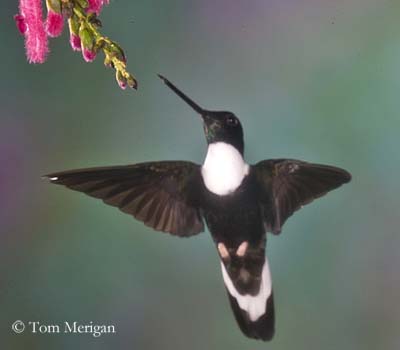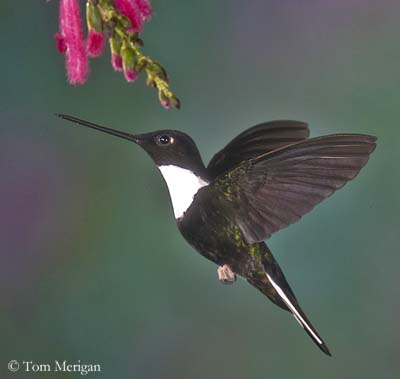
Fr: Inca à collier
All : Brustband-Andenkolibri
Esp : Inca Acollarado
Ital: Colibrì inca dal collare dell'Ecuador
Nd: Gekraagde Inkakolibrie
Photographer :
Tom Merigan
Tom Merigan’s Photo Galleries
Text by Nicole Bouglouan
Sources :
HANDBOOK OF THE BIRDS OF THE WORLD Vol 5 by Josep del Hoyo-Andrew Elliott-Jordi Sargatal - Lynx Edicions - ISBN: 8487334253
A GUIDE TO THE BIRDS OF COLOMBIA by Steven L. Hilty and William L. Brown - Princeton University Press – ISBN 069108372X
BirdLife International (BirdLife International)
Collared Inca
Coeligena torquata
Apodiforme Order – Trochilidae Family
BIOMETRICS:
Length: 14-15 cm
Weight: 6,5 – 7,3 g
DESCRIPTION:
The Collared Inca is a common hummingbird species found in the humid forest of the Andean mountains.
Adult male has blackish-green upperparts, greener on lower back. The tail is forked.
On the underparts, chin and throat are black, with green feather’s edges. We can see a conspicuous broad white collar. Lower breast and belly are blackish-green, but the undertail coverts are tinged green.
The undertail shows dark bronze-green inner tail feathers. The other rectrices are white with contrasting dark bronze-green tips of various sizes.

Head is black with dark purple crown spot. The long black bill is straight. Eyes are dark brown with white postocular spot. Legs and feet are pale pink with black claws.
Female lacks the purple crown spot and her head is washed green. The glossy upperparts are golden-green. On the underparts, chin is rather grey with some green edges. She has the broad white collar, but the belly is dark grey with some golden-green edges. Undertail coverts are grey-green edged white. Her tail is less forked than in male.
Immature is similar to adult female, but the head feathers show buffy fringes.
We find six subspecies sharing the Andean range. They differ in coloration of plumage with different crown spots and more or less green body plumage.
VOICE: SOUNDS BY XENO-CANTO
The Collared Inca utters high-pitched chirps and whistles. These sounds are brief and uttered by both sexes as advertising calls when they are feeding at abundant food sources.
When defending the territory, they give series of aggressive rapid chattering. The alarm calls are similar to contact calls but shriller and given at higher frequency. They are uttered when predators approach the nest-site, or enter the territory or the feeding area.
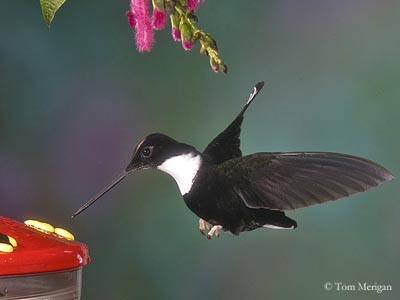
HABITAT:
The Collared Inca frequents humid and wet montane forest and shrubby forest borders, and can be seen from the understorey to the lower canopy.
It is usually found at 2200-3000 metres of elevation, but sometimes at 1500 metres, according to the season and the region.
There is no available information about migrations, but they probably perform seasonal movements over short distances, and some post-breeding dispersions.
RANGE:
The Collared Inca is found in the Andes, from W Venezuela, through Colombia and Ecuador, to Peru.
BEHAVIOUR:
The Collared Inca feeds on nectar from several plant species. It also takes arthropods by hawking, or when gleaning in vegetation.
This hummingbird forages from the understorey to the lower canopy-level, at forest edges or in dense vegetation.
It is very active and silent when it feeds by “trap-lining”, visiting specific plant species. It hovers below the pendent flowers in order to reach the nectar with the bill and the tongue.
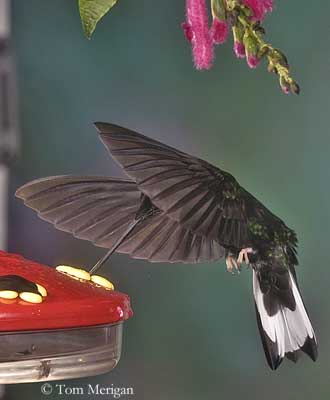
As other hummingbird species, it defends its food-sources by uttering songs, and performing gorget displays towards the other birds. Aerial displays are rarely observed.
Courtship displays are similar to defence displays.
FLIGHT:
The Collared Inca performs hovering flight, remaining almost motionless when feeding on nectar from exposed flowers.
The wing move in horizontal plan and describe a flat 8 with the wing tips. They can move forwards, backwards and sidewards, but they also perform up and down movements.
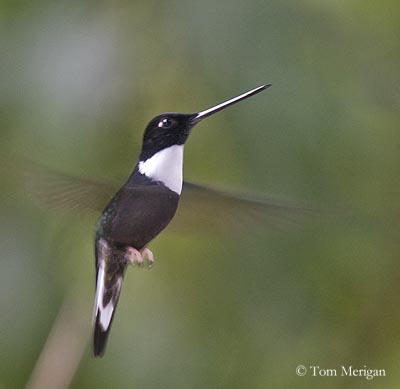
REPRODUCTION:
Breeding season occurs between November and March in Colombia.
The nest of the Collared Inca is situated on rock cliffs, hidden under ferns at about 1, 50 to 2 metres above the ground.
The pretty nest is made with plant fibres and the outer part is heavily decorated with moss and dead leaves of ferns.
The female lays two eggs.
There is not available information about the nesting behaviour of this species.
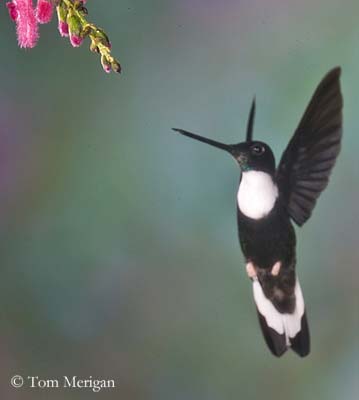
DIET:
The Collared Inca feeds on nectar from flowers and hawks or gleans arthropods from the vegetation.
PROTECTION / THREATS / STATUS:
The Collared Inca is very common throughout the Andean range. However, it is threatened by habitat destruction with deforestation, and this species could suffer in near future.
Large parts of the habitat are protected in Colombia and Ecuador.
This species is not threatened at this moment.
